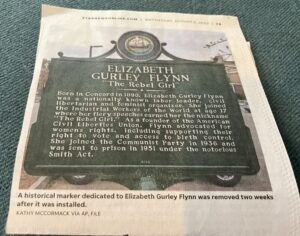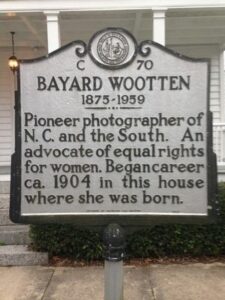HISTORICAL MARKERS: Women etched, not chiseled
“God cannot alter the past, though historians can.” Samuel Butler
Looking for statues is like going on a treasure hunt. Sometimes I’m lucky and she’s easy to find, almost as if she wants me to seek her out (see Umi, Oct 2023). Other times I need to follow the clues because she’s either adjacent to where I’m traveling (see Luna Girls, June 2020) or hiding off the beaten path (see Reproductive Freedom Monument, March 2023). But more often than not, I come up short and wind up improvising (see Sedona, Nov. 2023). Recently, though I added historical markers to my search, hoping I might be more successful. And guess what? Women suffer the same fate in this category- less women’s names or accomplishments have been etched on markers as their male counterparts. It shouldn’t have surprised me, but it did.
What exactly are historic markers and why are the names on them mostly members of the patriarchy? Same old story, I’m afraid. Either men were uninterested in what women were doing or were jealous of them and thus sabotaged or silenced their accomplishments; burying their names to keep future generations from getting any (intellectual, economic or entrepreneurial) ideas. Or men wanted women written out of history.
Historically, markers began in the United States in the last 1920’s as a way to mark, name, or identify a plot of land as having historical merit or significance. They became a symbolic inscription; territorial place holders that said: Something happened here. Their purpose was to educate, inform and raise awareness. Take note. Remember this place, person or event. Not all memories are pleasant, some, downright horrific. But we must be the historians who don’t alter the past. Inscribe it as it was. Include everyone. Don’t leave anything out.
Most markers are state/locally funded and maintained. The good news- there’s a national movement funded and organized by the National Collaboration of Women’s Historic Sites that will install 250 markers of women suffragettes who raced on the road to the 19th Amendment. Sometimes markers are used instead of statues because they’re less expensive to install, take fewer hours to develop and don’t take up as much space. The downside is that most markers are made of aluminum which has a much shorter shelf life than stone. But it’s a good start.
Here are a few markers of note I uncovered on recent trips: Meredith College in Raleigh, NC installed a marker to recognize outstanding females in the field of mathematics ; Bayard Wootten, an artist, installed in Tryon Palace in New Bern, NC, was a pleasant surprise. In New Hampshire, I not only discovered a marker but I found controversy. No sooner was the marker for Elizabeth Gurly Flynn known as “The Rebel Girl” installed, naysayers petitioned to have it removed because of her unorthodox belief system (there is currently another legal battle to have it re-installed). Ms. Flynn’s statue is one of 275 that are being installed statewide to recognize influential people from the Revolutionary War to contemporary era (so far, her marker is the only one that’s been uninstalled). Makes me wonder if it was her gender and not her politics that fuel the opposition.
Ho hum. Progress is being made, but slowly. We can do better. Be proactive. Start in your home town. Find women who’ve had made significant contributions to society and petition to have a statue erected (think big) or a historical marker. Collaborate with businesses with deep pockets, access to grants or those with political clout. Keep in mind, the past was not kind to women, people of color and those with different sexual orientation. We need to right the wrongs. One marker, one statue at a time. If historians can alter the past, as Mr. Butler surmises, then they can also alter the present landscape. Clusters the markers if you can; turn it into a trail or pathway.
The more women’s names and accomplishments we can chisel or etch into stone or medal is a win. Our daughters, granddaughters and great granddaughters will be grateful. Men will thanks us too, if they already haven’t.


